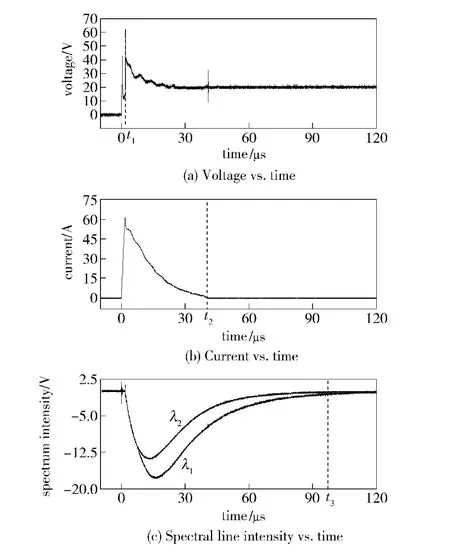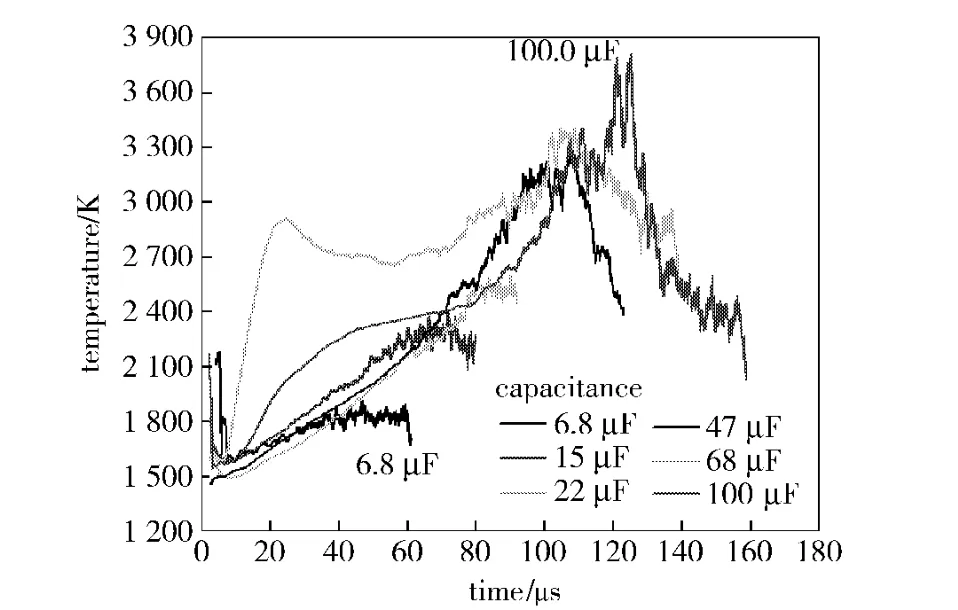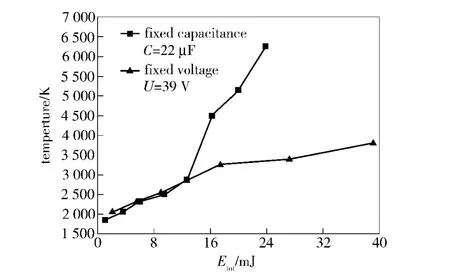Experimental Study on Plasma Temperature of Semiconductor Bridge
2012-03-09WURong吴蓉ZHUShunguan朱顺官ZHANGLin张琳LIYan李燕FENGHongyan冯红艳
WU Rong(吴蓉),ZHU Shun-guan(朱顺官),ZHANG Lin(张琳),LI Yan(李燕),FENG Hong-yan(冯红艳)
(1.Department of Chemistry and Material Science,Chaohu University,Chaohu 238000,Anhui,China;2.School of Chemical Engineering,Nanjing University of Science & Technology,Nanjing 210094,Jiangsu,China;3.School of Chemistry and Material Science,University of Science and Technology of China,Hefei 230026,Anhui,China)
Introduction
The semiconductor bridge is a small electronic device[1]which has developed very rapidly due to its excellent properties[1-7],such as high safety,low energy and readiness of incorporation with digital logic circuits.A current pulse applying to the SCB produces a high-temperature plasma which is particularly efficient in igniting granular explosive materials[1],thus,the information on the plasma temperature is very important to understand the SCB discharge behavior.As the duration of SCB plasma is only hundreds of microseconds and its diameter is less than 2 mm and the temperature changes dramatically in the air,most of common diagnostic techniques for plasma are inefficient.Spectroscopic diagnostic technique is a well known and powerful tool,and it can be applied to determine the plasma temperature.
Lots of researches studied the SCB plasma temperature,such as Benson,et al.[1],Thomas,et al.[8]and Kim,et al.[9].However,the instrument used in experiments is very expensive.Based on the dual line spectra of atomic emission,the plasma temperature measurement system built by YANG Dong,et al.[10],LIU Da-bin,et al.[11]and ZHOU Xin-li,et al.[12]and developed by FENG Hong-yan,et al.[13]and WU Rong,et al.[14-15]is a simple and more economical method to measure SCB plasma temperature.
In this paper,the plasma temperature under different discharge conditions is studied in real time.The effects of discharge voltage,charging capacitor and pulse energy on the plasma temperature are investigated.The results provide some experimental basis for further research on the plasma effect,ignition circuit and detonation mechanism.
1 Temperature Measurement Based on Atomic Emission Spectrometry
Based on the atomic emission spectroscopy theory[16],electrons in atoms can be excited to high energy states when they absorb energy and then return to lower energy states,and in this course,the excess energy can be released in the form of light and produce atomic spectrum.According to the assumption of local thermodynamic equilibrium(LTE),the electron temperature Tecan be assumed equal to the excitation temperature Texc,namely Te=Texc=T,the plasma temperature T can be estimated by using the following equation.

where the subscripts 1 and 2 stand for two transitions,λ1and λ2are the wavelengths of the spectral lines selected for temperature measurement,I1and I2are the relative intensities of the lines,A1and A2are the transition probabilities of the lines,g1and g2are the statistical weight of the lines in higher level,E1and E2are the energies of the lines in higher level,k is Boltzmann’s constant,T is the temperature of plasma.From Eq.(1),the temperature can be expressed as

For two given spectral lines,A1,A2,g1,g2,λ1,λ2,E1,E2and k are all constants.When the relative intensities,I1and I2,are determined,the plasma temperature can be calculated easily from Eq.(2).
There isminim Cu element in SCB which has been detected by atomic absorption spectrometry and inductively coupled plasma mass spectrometry.Because its two lines are near and well isolated,the spectral lines of 510.5 nm and 521.8 nm of Cu atom are chosen to estimate the temperature.Their spectral parameters are shown in Tab.1.

Tab.1 Spectral parameters of Cu atomic lines[17]
2 Experimental Setup
A kind of polymorphic silicon SCB of 60 μm in length,350 μm in width and 2 μm in thickness is used in the experiment,as shown in Fig.1.Its electrical resistance is 1 Ω approximately.When the SCB is excited by an input electric pulse,the bridge material melts,entirely vaporizes and creates a high-temperature plasma.
The experiment system to measure SCB plasma temperature is shown in Fig.2.The plasma is generated by the rapid discharge of electrical energy into a poly-silicon substrate located between two gilded electrodes.SCB is excited by using a capacitor ignition cir-cuit after the capacitor is charged by a power supply.Once the SCB plasma discharge is initiated with breakdown of the electrical energy between two gilded electrodes,the subsequent ablation and ionization of material from the surface of poly-silicon sustains the main plasma discharge.

Fig.1 Structure of SCB

Fig.2 Block diagram of temperature measurement system
Two lightbeams separated from the original plasma light through optical fibers enter into two different wavelength interference filters,then the light signals are amplified by two photo-multiplier detectors(R300)and they are transformed into electric signals.These two electric signals,voltage signal and current signal,in the SCB are recorded by a multi-channel oscilloscope LeCroyLT374 simultaneously.
The plasma spectrum intensity signals and the discharge pulse signal in the same time under different discharge conditions are obtained by the system.In the same conditions,the experiment is performed three times.
3 Results and Discussions
The typical curves of discharge voltage,current and spectral line intensity under 22 μF and 57 V are shown in Fig.3(a - c).
Fig.3(a)shows the measured curve of voltage applied to SCB.It can be seen that there exist two voltage peaks.The corresponding current is shown in Fig.3(b).As described by Benson,et al.[1],the first peak occurring at the leading edge of the current pulse corresponds to the initial silicon heating prior to the silicon vaporization.Before the vaporization ends,a lower impedance status exists in the bridge.The plasma heating stage,as the beginning of the late time discharge(LTD)phase,is marked as time t1in Fig.3(a).At the beginning of LTD,the bridge impedance rises rapidly to about twice of that of the original bridge.Only when the plasma heating phase forms,SCB producing hot plasma can ignite explosive materials.LTD continues to the end of the current pulse and the time is marked as t2in Fig.3(b).
The plasma spectrum intensity presented as voltage is shown in Fig.3(c).It shows that the SCB plasma is sustainable from t1to t3,in accordance with the conclusion of Kim,et al.[2].

Fig.3 Voltage,current and spectrum intensity vs.time
3.1 Relationship Between Plasma Temperature and Voltage
Based on the temperature measurement principle of dual spectral lines,the plasma temperature can be calculated from the relative intensity ratio of two Cu spectral lines according to Eq.(2).
Keeping the capacitance as 22 μF,the changes of plasma temperature are measured in the voltages of 21,27,33,39,45,51,57 and 63 V,respectively,as shown in Fig.4.

Fig.4 Plasma temperature curves in different discharge voltages(capacitance:C=22 μF)
It can be seen from Fig.4 that the plasma temperature increases first and then decreases with the time.The peak temperature increases from 2 000 K to 6 200 K with the voltage increase.
3.2 Relationship Between Plasma Temperature and Capacitance
Keeping the discharge voltage as 39 V,the changes of the plasma temperature are measured in different capacitors,6.8,15,22,47,68 and 100 μF,as shown in Fig.5.It can be seen that the plasma temperature increases first and then decreases also.The peak temperature increases from 2 200 K to 3 800 K gradually with the capacitance increases.
3.3 Relationship Between Plasma Temperature and Pulse Energy
The energy dissipated in SCB before the beginning of LTD is called as critical ignition energy and denoted as Ec.The total energy in the pulse discharge is called as pulse energy and denoted as Etot.The change of the plasma temperature is studied under these two energies.

Fig.5 Plasma temperature curves in different capacitances(discharge voltage:U=39 V)
The experiment results show that Eckeeps constant in different discharge voltages and capacitors,and the plasma temperature is basically within 1 700 K to 2 200 K.It means that the energy dissipated in the SCB before the beginning of LTD depends only on the type of bridge.When the SCB is excited by an electric pulse with energy Ec,the bridge material will melt,entirely vaporize and form a high-temperature plasma.The initial plasma temperature at the beginning of the LTD changes slightly under different discharge pulses.

Fig.6 Plasma temperature vs.pulse energy
The changes of peak plasma temperature with pulse energy Etotunder in different discharge conditions,different capacitances in fixed voltage or different voltages in fixed capacitance,are shown in Fig.6.It can be concluded that the plasma temperature in-creases with the increase of Etot.The plasma temperature changes a little when Etotis relatively low.However,if Etotis higher,for example,above 12.7 mJ,the change of discharging voltage has a greater effect on the plasma temperature than that of the capacitance.Therefore,the high plasma temperaturescan be achievedby increasing the discharge voltage.
4 Conclusions
Based on the dual lines temperature measurement principle and using the real-time plasma temperature measurement system,the electric energy acting on SCB and the produced plasma spectral intensity signal in different discharge pulses are recorded simultaneously for analysis.Conclusions can be drawn as follows.
1)The plasma spectral intensities are measured experimentally in different capacitances and discharge voltages.The plasma temperatures are calculated according to experiment results and Eq.(1).SCB plasma temperature changes rapidly and transiently.When the capacitance is 22 μF and the discharge voltage increases from 21 V to 63 V,the peak plasma temperature rises from 2 000 K to 6 200 K;when the discharge voltage is 39 V and the capacitance changes from 6.8 μF to 100 μF,the peak temperature of plasma rises with the increase of the charging capacitance from 2 200 K to 3 800 K.
2)At the beginning of LTD,the energy consumed by SCB is basically constant in conditions of different discharge pulses.It depends on the type of SCB and will not change under various conditions if the energy reaches a certain threshold Ec.The plasma temperature also keeps constantly within 1 700-2 200 K.
3)With the increase of pulse energy acting on SCB,the plasma temperature rises gradually.When the discharge voltage is changed,the influence of pulse energy change on the temperature is greater than that of the capacitance change.
[1]Benson D A,Larsen M E,Renlund A M,et al.Semiconductor bridge:a plasma generator for the ignition of explosives[J].Journal of Applied Physics,1987,62(5):1622-1632.
[2]Kim J D,Kim S G,Jungling K C,et al.Correlated electrical and optical measurements of firing semiconductor bridges[J].Journal of Vacuum Science& Technology B,1997,6(15):1943-1948.
[3]ZHOU Rong,YUE Su-ge,QING Hui-qian,et al.Study of semiconductor bridge[J].Chinese Journal of Semiconductors,1998,19(11):857-860.(in Chinese)
[4]WANG Zhi-ping,FEI San-guo,GONG Yan-qing,et al.The experimental research on the initiation of explosives by semiconductor bridge[J].Explosion and Shock Waves,2000,20(4):359-363.(in Chinese)
[5]Kim J D,Roh T M,Cho K I,et al.Optical characteristics of silicon semiconductor bridges under high current density conditions[J].IEEE Transactions on Electron Devices,2001,48(5):852 -857.
[6]Lee K N,Park M I,Choi S H,et al.Characteristics of plasma generated by polysilicon semiconductor bridge(SCB)[J].Sensors and Actuators A:Physical,2002,96(2-3):252-257.
[7]ZHU Feng-chun,XU Zhen-xiang,CHEN Xi-wu,et al.Progress on the semiconductor bridge Initiator[J].Acta Armamentarii,2003,24(1):106-110.(in Chinese)
[8]Thomas K A,Baginski T,Rogers J W.Spectroscopic investigations of an exploding semiconductor[C]∥Proceedings of the IEEE International Conference on Plasma Science.United States:IEEE,1994:123-124
[9]Kim J U,Park C O,Park M I,et al.Characteristics of semiconductor bridge(SCB)plasma generated in a microelectro-mechanical system(MEMS)[J].Physics Letters A,2002,305(6):413-418.
[10]YANG Dong,WANG Jun-de,ZHAO Bao-chang,et al.Combustion gas temperature measurement in the chamber of solid rocket motor by double line of atomic emission spectroscopy[J].Spectroscopy and Spectral Analysis,2002,22(2):307-310.(in Chinese)
[11]LIU Da-bin,YANG Dong,JIANG Rong-guang,et al.Spectroscopic determination of the dynamic electrical spark temperature of nonel tube igniter[J].Spectroscopy and Spectral Analysis,2002,22(4):670 - 672.(in Chinese)
[12]ZHOU Xin-li,LI Yan,LIU Zu-liang,et al.Transient detonation temperature measurement of explosives using spectroscopic method[J].Spectroscopy and Spectral A-nalysis,2003,23(5):982-983.(in Chinese)
[13]FENG Hong-yan,LI Yan,ZHANG Lin,et al.Measurement of the semiconductor bridge(SCB)plasma temperature by the double line of atomic emission spectroscopy[J].Chinese Journal of Energetic Materials(Hanneng Cailiao),2007,15(2):134-136.(in Chinese)[14]WU Rong,ZHU Shun-guan,ZHANG Lin,et al.Experimental investigation on the temperature of semiconductor bridge(SCB)plasma[C]∥Theory and Practice of Energetic Materials(Vol.VII),Beijing:Science Press,2007:874-878.(in Chinese)
[15]WU Rong. Experimental investigation and emission spectroscopy diagnostics of semiconductor bridge plasma temperature[D].Nanjing:Nanjing University of Science& Technology,2007.
[16]《Emission Spectral Analysis》Compile Group.Emission spectral analysi[M].Beijing:Metallurgical Industrial Press,1977.(in Chinese)
[17]Lide D R.CRC handbook of chemistry and physics[M].66th Ed.Florida:CRC Press,1985-1986.
猜你喜欢
杂志排行
Defence Technology的其它文章
- Research on Coordinated Antisumarine Attack Effeciency of Two Helicopters Under Countermeasures
- Design of ANSYS-based Cathode with Complex Groove
- Study on Stable Scanning of Terminal Sensing Ammunition Based on Quaternion Transformation
- Experimental Investigation on Space-dispersed Double-wall Jet Combustion System for DI Diesel Engine
- Research on Three-Echelon Inventory Model and Algorithm for Valuable Spare Parts in Weapon Equipment
- Experimental Research on Influence of Some Factors on Ejection Height of Cargo Projectile
